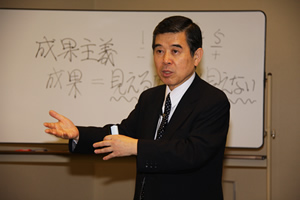1. Safety management presented comprehensively

Michio Yoshida, professor of the Center for Educational Research and School Development, Faculty of Education, Kumamoto University |
Michio Yoshida, professor of the Center for Educational Research and School Development of the Faculty of Education of Kumamoto University was invited to present information on safety management and skills-enhancement methodology in human relationships. The summary of his presentation is as follows.
・There are numerous right answers to the question of how to carry out activities that promote the safety culture depending on the diversity of conditions in individual companies and the workplaces of the participants. In this seminar, I would like to provide participants with some help as they search for the answers most suitable to their respective workplaces, by way of presenting actual examples.
・We cannot readily conclude that the troubles and accidents in nuclear power facilities will be eliminated only if the proper legislation is put into place and if the equipment installed is comprehensive. Rather, we need to establish conditions whereby the software or the human-feeling factor is also working, whereby checks are conducted when someone “feels that some aspect of operations is unsafe”, and by putting into place the hardware that yields a “fail-safe” environment.
・Although it is necessary emphasize results, we also need to keep in mind that there are two kinds of results--“visible results” and “invisible results”. Generally, we tend to overlook the importance of “invisible results” while paying too much attention to “visible results”. The “invisible results” include the levels of motivation and satisfaction. It is not necessary to try to grasp these factors by strict measurement, but it is desirable to grasp the trends of these factors and to evaluate them as important “results”.
・With regard to motivation, it is a strong organization where the environment of the organization is such that “the worker is praised when he or she does a good job” and “is expected to challenge a task once again even when he or she fails”, instead of an environment where “a worker is working involuntarily or grudgingly” .
・It is possible to improve levels of safety and productivity just by raising the levels of motivation and satisfaction--which are invisible results. I advise that you attach great importance to the invisible parts-- the parts from the “heart”--such as motivation and eagerness.
・When we learn how we can have smooth communications, it becomes clear that the relationship between the person conveying the message and the person receiving it plays a role of paramount importance. For instance, if the two persons have a good human relationship, it is possible to have good communication between them even if one person conveys only 80 percent of what he/she intends to say. This is because the person on the receiving end fills in the remaining 20 percent of the message and thereby the full message gets across. This means that it is critical to have a good human relationship in order to have good communication, in which the intent of the person conveying the message can be communicated fully to the person receiving receives it, not to mention the importance of conveying the messages correctly.
・It is necessary to have a concept that allows both safety and efficiency to work together. If a worker can expect to be properly evaluated if he or she proposes an idea that enhances safety, if such an environment is established, everyone can perform his or her work accompanied by a feeling of well-being. As a result, the possibilities of realizing a safe workplace are magnified with only a modest cost outlay.
・Not only is ability required on the part of leaders, but also the ability to support leaders is required on the part of the people who follow the leader. Although, basically, leadership flows from top to bottom, there is an aspect whereby the people who follow the leader also help develop capable leaders. In addition, the larger the number of followers, the greater becomes the significance of the strength of the leader as a human being, in addition to his competency as a professional. Unless a leader keeps his or her strength polished as a human being, it will become difficult for him or her to perform as a leader in front of followers, and this is in addition to increasing his or her knowledge and skills base.
・Whether he or she is a good leader or not is determined by the actions the leader takes, instead of the qualifications of the leader as an individual. In other words, it is not an issue what kind of characteristics the leader has. What is important is what kind of actions are being taken. A leader is expected to take every action that a leader is required to take.
・Speech and human behavior are closely related. Many times, actions are restricted by what is said. If a person has a large vocabulary, he or she can take diverse actions in accordance with that vocabulary.
・There are many kinds of “education” for developing the capacity of subordinates. For instance, “surprising education” is something that needs to be prized. “Surprising” is also connected with “praising”. In addition, “cooperating education”, in which people “cooperate with each other to promote education,” and “resonant education” in which people resonate with each other must be respected. In addition, “today education”, where a task that should be done today must not be put off” also needs to be prized.
・In contrast, we must avoid “threatening education”, where we threaten our subordinates, and “narrow education”, in which we push our own ideas upon our subordinates. But, it is unfortunate that there are many managers who are engaged in this kind of negative education without being aware of it. |







